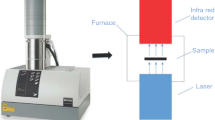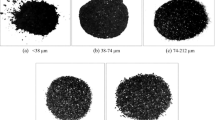Abstract
The imbibition ability of extinguishant is an important factor influencing the extinguishing effect for smoldering fire in pulverized coals. The coal particle size, bulk compactness, and aqueous solution properties significantly affect the imbibition ability of extinguishment. This work aims to reveal the influence of the properties of pulverized coals and aqueous solution on the imbibition ability of extinguishant for smoldering fire through experiments and capillary theories. The imbibition height and rate were adopted to evaluate the imbibition ability of extinguishment. The results showed that a relatively small bulk compactness and a fine coal particle size negatively influenced the extinguishing process dominantly because of its high surface energy and low wettability. An additive was used to adjust the properties of aqueous solution. The liquid with a larger surface tension, a smaller contact angle, and a lower viscosity induced a better imbibition ability of extinguishment.





Similar content being viewed by others
References
Malav D, Ganguli R, Dutta S et al (2008) Non-impact of particle size distribution on power generation at a pulverized coal power plant burning low rank Alaska coal. Fuel Process Technol 89(5):499–502
Song Z, Zhu H, Jia G et al (2014) Comprehensive evaluation on self-ignition risks of coal stockpiles using fuzzy AHP approaches. J Loss Prev Process Ind 32:78–94
Song Z, Fan H, Jiang J et al (2017) Insight into effects of pore diffusion on smoldering kinetics of coal using a 4-step chemical reaction model. J Loss Prev Process Ind 48:312–319
Lohrer C, Schmidt M, Krause U (2005) A study on the influence of liquid water and water vapour on the self-ignition of lignite coal-experiments and numerical simulations. J Loss Prev Process Ind 18(3):167–177
Zhou X, Liao G, Bo C (2006) Improvement of water mist’s fire-extinguishing efficiency with MC additive. Fire Saf J 41(1):39–45
Wu B, Liao G (2013) Experimental study on fire extinguishing of water mist with a newly prepared multi-component additive. Proc Eng 62:317–323
Rakowska J, Prochaska K, Twardochleb B et al (2014) Selection of surfactants as main components of ecological wetting agent for effective extinguishing of forest and peat-bog fires. Chem Pap 68(6):823–833
Dey S (2012) Enhancement in hydrophobicity of low rank coal by surfactants—A critical overview. Fuel Process Technol 94(1):151–158
Hadden R, Rein G (2011) Chapter 18—Burning and water suppression of smoldering coal fires in small-scale laboratory experiments. Coal Peat Fires Global Perspect 1:317–326
Kim J, Kim HY (2012) On the dynamics of capillary imbibition. J Mech Sci Technol 26(12):3795–3801
Dong M, Chatzis I (2010) Effect of capillary pressure on wetting film imbibition ahead of main liquid-gas displacement front in porous media. Liq Fuels Technol 28(9):955–968
Lucas R (1918) Ueber das zeitgesetz des kapillaren aufstiegs von flüssigkeiten. Colloid Polym Sci 23(1):15–22
Washburn EW (1921) The dynamics of capillary flow. Phys Rev 17(3):273–283
Lane KS, Washburn DE, Krynine DP (1947) Capillarity tests by capillarimeter and by soil filled tubes. Highw Res Board Proc 26:460–473
Handy LL (1960) Determination of effective capillary pressures for porous media from imbibition data. Pet Trans AIME 219:75–80
Kim E, Whitesides GM (1997) Imbibition and flow of wetting liquids in noncircular capillaries. J Phys Chem B 101(6):855–863
Zhmud BV, Tiberg F, Hallstensson K (2000) Dynamics of capillary rise. J Colloid Interface Sci 228(2):263–269
Li K, Horne RN (2000) Characterization of spontaneous water imbibition into gas-saturated rocks. SPE J 6(4):375–384
Amico SC, Lekakou C (2002) Axial impregnation of a fiber bundle. Part 1: Capillary experiments. Polym Compos 23(2):249–263
Fries N, Dreyer M (2008) An analytic solution of capillary rise restrained by gravity. J Colloid Interface Sci 320(1):259–263
Cai J, Yu B, Zou M et al (2010) Fractal Characterization of spontaneous co-current imbibition in porous media. Energy Fuels 24:1860–1867
Chaturvedi T, Schembre JM, Kovscek AR (2009) Spontaneous imbibition and wettability characteristics of Powder River Basin coal. Int J Coal Geol 77(1–2):34–42
Hatiboglu CU, Babadagli T (2007) Oil recovery by counter-current spontaneous imbibition: effects of matrix shape factor, gravity, IFT, oil viscosity, wettability, and rock type. J Pet Sci Eng 59(1–2):106–122
Cai J, Hu X, Standnes DC et al (2012) An analytical model for spontaneous imbibition in fractal porous media including gravity. Colloids Surf A Physicochem Eng Asp 414:228–233
Yang D, Krasowska M, Priest C et al (2012) Dynamics of capillary-driven flow in open microchannels. J Phys Chem C 115(38):18761–18769
Li Q, Lin B, Zhao S et al (2013) Surface physical properties and its effects on the wetting behaviors of respirable coal mine dust. Powder Technol 233:137–145
Pan G, Huang Q, Hu H et al (2010) Wettability of superhydrophobic surface through tuning microcosmic structure. Polym Mater Sci Eng 26:163–166
Acknowledgements
This study was supported by the Key Technical Research Plan of Ministry of Public Security (No. 2017JSYJA13) and Independent Innovation Fund of Tianjin University (No. 1706).
Author information
Authors and Affiliations
Corresponding author
Rights and permissions
About this article
Cite this article
Liu, L., Gong, H., Shi, X. et al. Effects of the Imbibition Ability of Extinguishant in Pulverized Coals. Trans. Tianjin Univ. 25, 45–51 (2019). https://doi.org/10.1007/s12209-018-0140-z
Received:
Revised:
Accepted:
Published:
Issue Date:
DOI: https://doi.org/10.1007/s12209-018-0140-z




